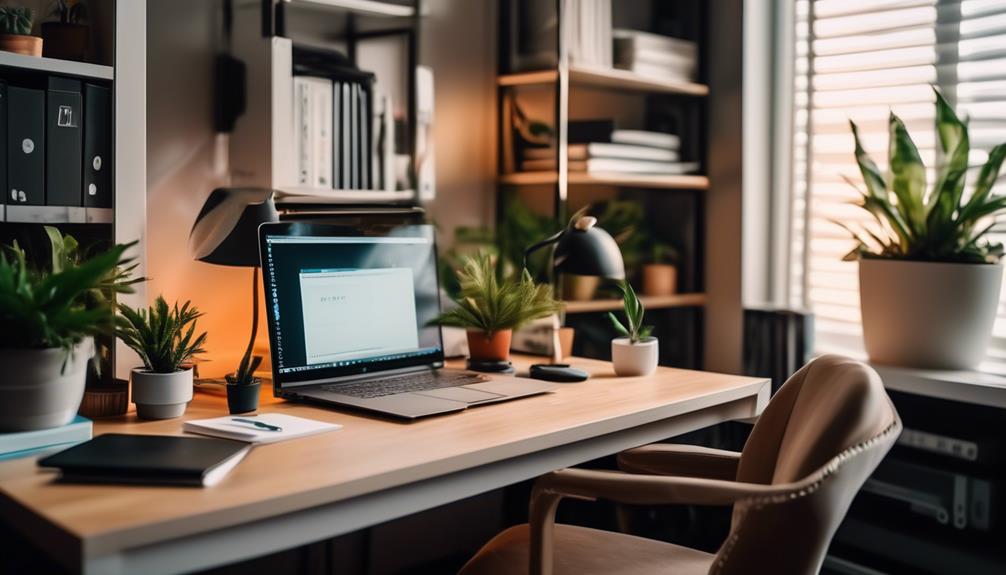Working from home as a parent presents unique challenges when it comes to maintaining a productive and organized home office environment. Balancing professional responsibilities with parenting duties requires a well-organized space that promotes efficiency and minimizes distractions.
In this write-up, we will explore practical tips and strategies for home office organization specifically tailored to work-from-home parents, helping them create a functional and conducive workspace within the comfort of their homes.
Decluttering and Organizing Your Workspace
If you want to create a productive workspace, it’s essential to declutter and organize your home office. A cluttered and disorganized workspace can hinder your productivity and make it hard to focus on your tasks.
Start by decluttering your workspace. Get rid of any unnecessary items that are taking up space and causing visual distractions. Take the time to sort through your paperwork and toss any old documents or files that you no longer need. Investing in a good filing system will make it easier to keep your important documents organized and within reach.
Next, make sure to organize your supplies. Keep frequently used items, like pens, notepads, and sticky notes, within arm’s reach. Utilize desk organizers and drawers to store your supplies in an orderly manner. If you have larger items, consider using storage bins or shelves to keep them neatly tucked away.
It’s also a good idea to create designated areas for different tasks. Set aside a specific area for your computer, writing materials, and any other equipment you use regularly. This will help you stay focused and avoid cluttering your workspace with unnecessary items.
Lastly, make it a habit to maintain your organized space. Take a few minutes at the end of each day to tidy up. Put away any items that have been left out and file away any loose papers. By doing this, you’ll ensure that your workspace remains clutter-free and ready for the next day’s work.
Establishing a Designated Work Area
Now that you have organized your workspace, it’s time to create a designated work area. This will help you be more productive as a work-from-home parent. Having a dedicated space for work is crucial for achieving a work-life balance and overall well-being.
Setting boundaries is important when working from home. By creating a designated work area, you physically separate your professional life from your personal life.
This separation allows you to mentally shift into work mode when you enter your workspace and transition back to your personal life when you leave it. It helps create a clear distinction between your roles as a parent and as a professional, enabling you to give your best to both aspects of your life.
When establishing your designated work area, choose a quiet corner of your home where you can concentrate without distractions. Make sure your work area is well-lit and comfortable, with a supportive chair and an organized desk. Personalize it with items that inspire and motivate you, such as photos of loved ones or motivational quotes.
It is also important to communicate the boundaries of your work area to your family members. Let them know that when you’re in your designated workspace, you’re focused on work and shouldn’t be disturbed unless it’s an emergency. This will help set expectations and minimize interruptions, allowing you to be more productive during your designated work time.
Choosing the Right Furniture and Equipment
When setting up your workspace, it’s important to carefully choose furniture and equipment that will support your productivity and keep you comfortable. One of the key aspects to consider is your chair and desk.
Opt for an ergonomic chair that provides proper back support and adjustable features to customize it to your needs. This won’t only help you stay focused but also prevent any potential health issues that may arise from sitting for long periods.
Similarly, finding the right desk is crucial. Look for a spacious desk that can accommodate all your work essentials, such as your computer, documents, and other equipment. Consider a desk with built-in storage options to help you stay organized and minimize clutter.
When it comes to technology, investing in reliable equipment is essential for efficient work. Ensure your computer or laptop meets your specific requirements, including processor speed, memory capacity, and storage options. This will guarantee smooth operation and ample space for your files.
In addition, a high-quality monitor, comfortable keyboard, and mouse can greatly enhance your productivity and reduce strain on your eyes and hands. It’s also important to have a reliable internet connection and consider a backup plan, such as a mobile hotspot or secondary internet service provider, to ensure uninterrupted work.
Utilizing Vertical Storage Solutions
Once you’ve set up your comfortable chair and spacious desk, it’s time to make the most of your workspace by using vertical storage solutions. By utilizing the wall space, you can free up valuable floor space and create a more organized and efficient home office. Vertical storage solutions not only help you keep your work area neat and tidy, but they also help you maximize your limited space.
One effective way to utilize vertical storage is by installing wall-mounted shelves or bookcases. These provide plenty of space for storing books, binders, and other office supplies while keeping them easily accessible. You can also use baskets or bins on the shelves to store smaller items and keep them well-organized.
Another option is to hang a pegboard on the wall. Pegboards offer a versatile and customizable solution for storing and organizing various items such as office supplies, cords, and even small tools. By using hooks, baskets, and holders, you can keep everything within reach without cluttering up your desk.
To add depth and complexity to your workspace, consider incorporating a wall-mounted filing system. This can be as simple as a set of wall pockets or a more elaborate file cabinet. By keeping your important documents within arm’s reach, you can save time and stay focused on your work.
Lastly, don’t forget about utilizing the space above your desk. Install floating shelves or wall-mounted cabinets to store items that you use less frequently, such as reference books or extra office supplies. This way, you can keep your workspace clutter-free while still having everything you need within reach.
Managing Cables and Cords Effectively
To effectively manage cables and cords in your home office, start by organizing them in a way that reduces clutter and ensures easy access when needed. Effective cable management is crucial for creating a clean and organized workspace that promotes productivity and reduces stress.
Messy cables not only make your home office look untidy, but they can also pose safety hazards and make it challenging to find the right cord when you need it.
One simple way to organize power cords is by using cable clips or cable ties. These useful tools allow you to group cords and keep them neatly organized. You can attach cable clips to the edge of your desk or use adhesive cable ties to secure cords along the back of your furniture. This not only prevents cords from tangling but also keeps them out of sight, creating a more visually appealing workspace.
Another effective method for managing cables is to use a cable management box or sleeve. These products are designed to hide and organize multiple cords, keeping them neatly contained and out of the way. Cable management boxes come in various sizes, so you can choose one that suits your needs and seamlessly fits into your home office decor.
Remember to label your cords to easily identify them when needed. Labeling power cords can save you time and frustration, especially when you have multiple devices connected to your workspace. You can use cable labels or even simple color-coded stickers to identify each cord’s purpose.
Creating a Filing System for Documents
To create an organized and efficient workspace, consider implementing a filing system for all your important documents. Having a well-organized filing system won’t only help you keep track of your documents but also save you time and reduce stress.
One of the first steps in creating a filing system is labeling your documents clearly and consistently. This will make it easier for you to locate them when needed. Use categories that make sense to you and your work-from-home setup. For example, you could have folders for invoices, contracts, client information, and tax documents.
In today’s digital age, paperless filing has become an increasingly popular option. It not only saves space but also reduces the risk of losing important documents. To implement paperless filing, you can scan your physical documents and store them digitally on your computer or in the cloud. Make sure to organize your digital files similarly to your physical files, using clear and descriptive file names.
Consider using a cloud storage service that offers secure and easy access to your files from anywhere. This way, you can access your documents whenever you need them, without the hassle of searching through physical folders.
Implementing Time Management Strategies
Start by prioritizing your tasks and creating a schedule to effectively manage your time as a work-from-home parent. Implementing productivity techniques is crucial in order to find a balance between your work and personal life.
As a work-from-home parent, it can be difficult to stay focused and productive with the many distractions that come with working from home. However, by implementing effective time management strategies, you can increase your productivity and create a work-life balance that works for you.
To start, prioritize your tasks by identifying the most important ones and their deadlines. This will help you allocate your time and energy accordingly. By focusing on the most important and urgent tasks first, you can ensure that you’re making progress while still making time for other responsibilities.
Creating a schedule is also essential for effective time management. Set specific times for work, breaks, and personal activities. By establishing a routine, you can stay on track and maintain a work-life balance. Remember to include breaks in your schedule to rest and recharge. This will prevent burnout and increase overall productivity.
In addition to prioritizing tasks and creating a schedule, there are other productivity techniques that can help you manage your time effectively. For instance, consider using time blocking, where you dedicate specific blocks of time to different tasks or projects. This will help you stay focused and avoid multitasking, which can decrease productivity.
Incorporating Ergonomic Practices for Comfort
Enhancing your work-from-home setup with ergonomic practices can greatly improve your comfort. Creating a comfortable workspace involves paying attention to your ergonomic desk setup and chair adjustment. Here are some tips to help you achieve a more ergonomic and comfortable work environment:
To start, adjust your desk height so that your wrists and forearms are in a neutral position. Your elbows should form a 90-degree angle when typing. This will help prevent strain on your wrists and arms.
Position your monitor at eye level to avoid straining your neck. If necessary, invest in a monitor stand to achieve the correct height. This will ensure that you maintain a comfortable and natural posture while working.
Organize your workspace in a way that keeps frequently used items within easy reach. This will minimize unnecessary stretching and reaching, reducing strain on your body. Consider using desk organizers or drawers to declutter your workspace and maintain a clean and organized area.
Adjust your chair’s height so that your feet are flat on the floor and your knees form a 90-degree angle. This will promote good posture and help reduce strain on your lower back.
Ensure that your chair provides proper lumbar support to maintain the natural curve of your lower back. If your chair lacks support, consider using a lumbar roll or cushion for added comfort.
Adjust the armrests of your chair so that your arms are relaxed and your shoulders aren’t hunched up. This will help prevent tension in your neck and shoulders, allowing for a more comfortable work experience.
Maximizing Natural Light and Adding Task Lighting
To maximize the amount of natural light in your home office, it’s important to strategically position your workspace near windows. This not only provides ample lighting but also offers a pleasant view, creating a more inviting and inspiring work environment.
Using sheer curtains or blinds can help control the amount of light streaming into your workspace, reducing glare and creating a comfortable and well-lit atmosphere.
It’s also crucial to arrange your furniture in a way that avoids blocking the flow of natural light. Make sure your desk and office equipment are positioned in a way that allows the light to reach your workspace without any hindrance.
In addition to natural light, incorporating task lighting can further enhance the illumination in your home office. There are several options to consider, depending on your specific needs. Desk lamps provide focused lighting for reading, writing, or other specific tasks.
Floor lamps can add additional light to the room, especially in areas where natural light may be limited. Under-cabinet lighting is a great option for illuminating work surfaces such as desks or countertops, enhancing visibility for detailed tasks.
Adjustable task lights are versatile and allow you to direct light exactly where you need it, providing flexibility and customized illumination. Finally, pendant lights can add both style and functionality to your home office, serving as a statement piece and a source of focused light.
Setting up a Digital Organization System
To keep your home office organized and efficient, it’s crucial to establish a digital system that simplifies your workflow and allows for easy access to important documents and files. By setting up a digital organization system, you can effectively manage your work-from-home responsibilities and create a productive and clutter-free environment.
Here are some steps to get started:
- Use a digital calendar: A digital calendar is a powerful tool that helps you stay on top of tasks and deadlines. Whether you choose a calendar app or an online platform, make sure to schedule your work hours, meetings, and important events. Set reminders for upcoming deadlines and color-code your entries for easy reference. With a digital calendar, you’ll never miss an important appointment again.
- Embrace cloud storage: Cloud storage is a game-changer for home office organization. Instead of cluttering your physical workspace with piles of papers, digitize your documents and securely store them in the cloud. Services like Google Drive, Dropbox, or OneDrive offer ample storage space and allow you to access your files from anywhere. Create separate folders for different projects or categories to keep everything organized and easily searchable.
- Establish a logical file naming system: When saving files digitally, it’s important to have a consistent and logical file naming system. Use descriptive names that include key information like dates, client names, or project titles. This will make it easier for you to locate specific files when needed. Additionally, consider using sub-folders within your cloud storage to further categorize and organize your documents.
- Regularly declutter and back up: Just like physical clutter can hinder productivity, digital clutter can also slow you down. Take the time to review your digital files regularly and delete any unnecessary or outdated documents. It’s also crucial to make it a habit to back up your important files regularly to ensure you don’t lose any crucial information.
Minimizing Distractions in Your Home Office
Eliminating distractions is crucial for maintaining focus and productivity in your home office. As a work-from-home parent, creating a space that allows you to concentrate on your tasks can be challenging, but it’s definitely achievable.
One effective way to minimize distractions is by investing in noise-canceling headphones. These headphones block out external noises and create a quieter environment, enabling you to stay focused on your work. Whether it’s the sound of kids playing or the noise from household chores, noise-canceling headphones can help you create a more serene atmosphere in your home office.
Another strategy to consider is establishing a no disturbance policy. Communicate with your family members about your need for uninterrupted work time and set clear boundaries. Let them know that when you’re in your home office, you should only be interrupted for emergencies.
Encourage them to respect your workspace and avoid unnecessary distractions. By setting clear expectations and boundaries, you can maintain a productive work environment.
Additionally, it’s important to eliminate potential distractions in your physical workspace. Keep your desk clutter-free and organized, so you can easily find what you need without getting sidetracked. Minimize visual distractions by decluttering your office space and keeping only essential items within reach. Consider using storage solutions like bins or shelves to keep your workspace tidy and free from distractions.
Optimizing Your Internet Connection and Speed
If you want to optimize your internet connection and speed, there are a few key steps you can take.
Make sure to position your router strategically in your home office. It’s best to place it in a central location and avoid any walls or obstructions that could interfere with the signal. If possible, elevate the router to help spread the Wi-Fi signal more evenly.
If you find that certain areas of your home office have weak Wi-Fi coverage, consider investing in a Wi-Fi range extender. This device amplifies the signal and expands the coverage, allowing you to work from any corner of your office without interruptions.
If your current router is outdated or not meeting your needs, it may be time to upgrade to a newer model. Look for routers with advanced features like dual-band technology, beamforming, and multiple antennas. These features can significantly improve your Wi-Fi coverage and signal strength.
Within your router’s settings, you can also optimize your Wi-Fi performance. Experiment with different channels to find the one with the least interference. Enable Quality of Service (QoS) settings to prioritize important tasks, and make sure to set a strong password to secure your network.
Establishing a Daily Routine and Schedule
Creating a daily routine and schedule is key to effectively managing your time and balancing work and family responsibilities. Start your day off right by establishing a morning routine. Wake up at a consistent time and engage in activities that energize you, like exercise or meditation. This will set a positive tone for the rest of the day.
Setting boundaries is crucial. Communicate your availability to your family and colleagues, making it clear when you’ll be working and when you’ll be available for family time. This will help avoid interruptions and allow you to focus on your work when needed.
To establish a productive routine, prioritize your tasks and allocate specific time slots for each. Break your work into manageable chunks and schedule breaks to rest and recharge. Remember to include time for meals and quality time with your family. Finding a balance that works for you and your loved ones is essential.
Stick to your schedule as much as possible, but also be flexible and open to adjustments. Life as a work-from-home parent can be unpredictable, so it’s important to adapt when necessary. Be kind to yourself and allow room for spontaneity and unexpected events.
Incorporating Plants and Greenery for a Calming Environment
Incorporating plants and greenery in your home office can create a calming environment that boosts productivity and overall well-being. Here are some simple ways to bring the benefits of greenery into your workspace:
- Choose low-maintenance plants: Opt for plants that require minimal care and can thrive indoors. Snake plants, pothos, and succulents are excellent choices as they can withstand different lighting conditions and require less watering. These plants add a refreshing touch to your workspace without demanding too much of your time and attention.
- Create a green corner: Dedicate a specific area of your home office to showcase your plants. Set up a stylish plant stand or shelf where you can display your green companions. This designated green corner adds a pop of color and creates a soothing atmosphere that promotes concentration and relaxation.
- Place plants strategically: Position your plants strategically to maximize their impact. Place them near your desk or in your line of sight, so you can enjoy their calming presence while you work. Studies have shown that having plants in your workspace reduces stress, increases focus, and boosts creativity.
- Go for natural scents: Consider adding plants with natural scents, such as lavender or eucalyptus, to your home office. These plants not only provide visual appeal but also release pleasant aromas that enhance your mood and create a spa-like atmosphere.
- Experiment with different sizes and shapes: Mix and match plants of various sizes and shapes to create visual interest. Incorporate hanging plants, tall plants, and small potted plants to add depth and dimension to your workspace. This variety makes your home office feel like a lush, inviting sanctuary.
Maintaining a Clean and Tidy Workspace
Keeping your workspace clean and organized is crucial for creating a productive and inviting environment. When your workspace is tidy, you’ll feel more motivated and focused on your tasks. Start by decluttering your desk and removing any unnecessary items.
Get rid of old papers, pens that no longer work, and anything else that’s taking up space. A clean surface will make it easier to find what you need and minimize distractions.
In addition to decluttering, it’s important to organize your supplies effectively. Invest in storage solutions like bins, drawers, and shelves to keep everything in its proper place. Sort your supplies into categories and label them accordingly, ensuring easy access and efficient use of space. By designating specific spots for your items, you’ll be able to locate them quickly, saving time and reducing frustration.
Make it a habit to clean your workspace regularly. Set aside time each day or week to dust surfaces, wipe down your desk, and vacuum the area. Keep cleaning supplies within reach, so you can easily deal with any spills or messes that occur during your workday.
Conclusion
When you work from home and have to balance parenting responsibilities, having a well-organized and efficient home office is crucial. Think of it as a peaceful oasis amidst the chaos.
Just as a beautiful garden nurtures growth, a clean and tidy workspace fosters productivity and creativity.
Take the time to declutter your office space, create a designated work area, and optimize your surroundings.
By organizing your space and adding a touch of greenery, you’ll find yourself thriving in this productive sanctuary.





